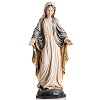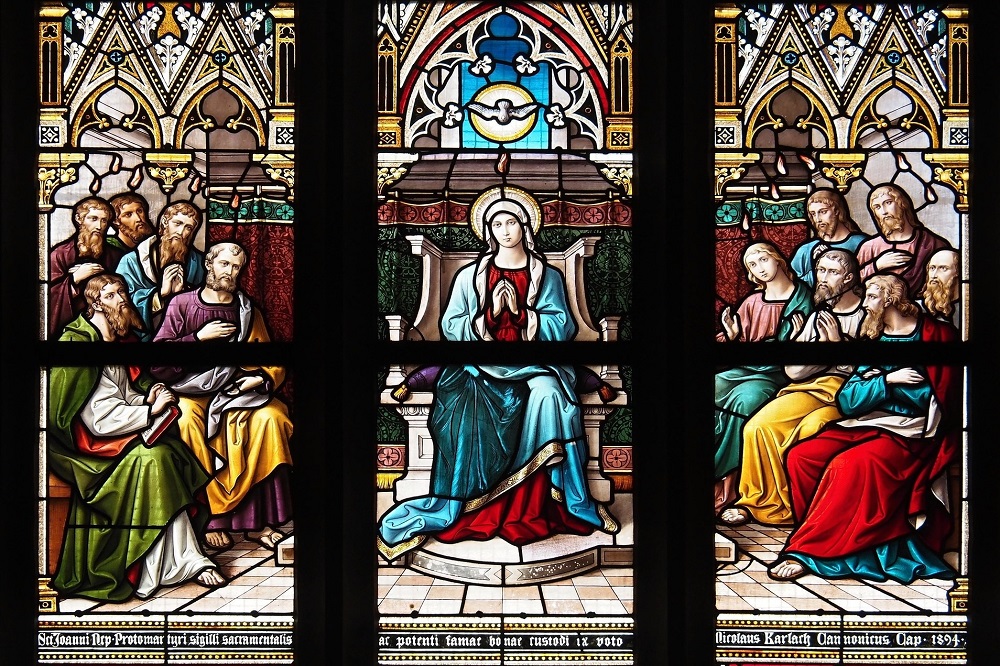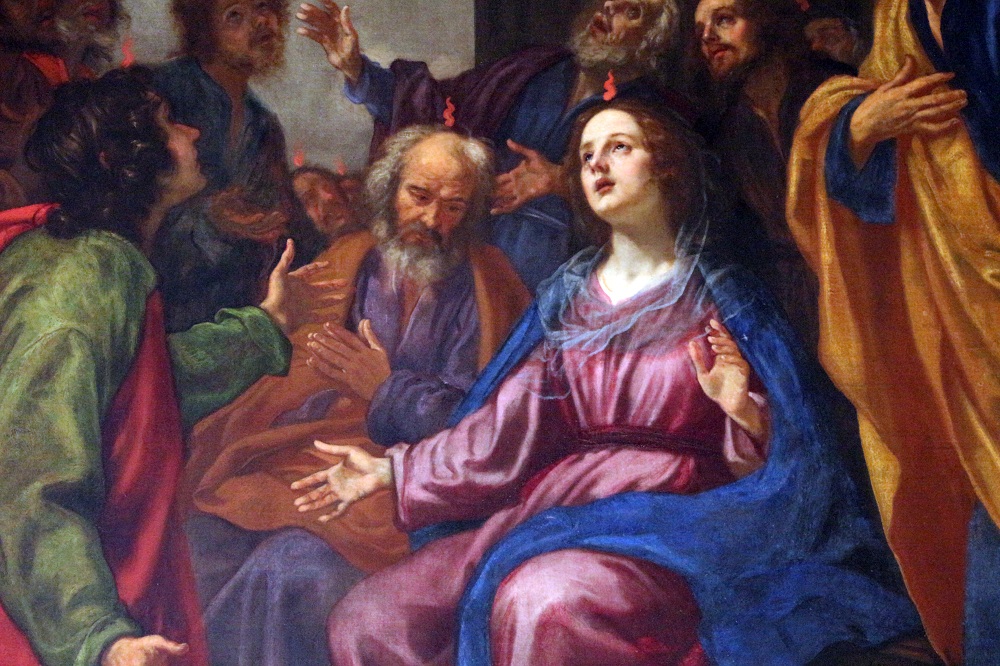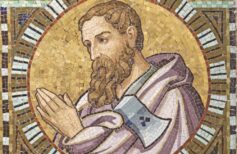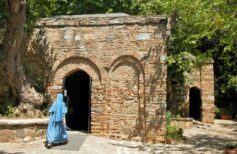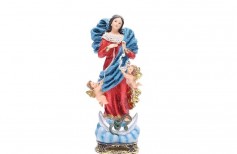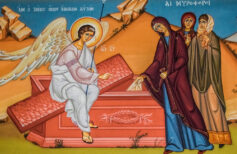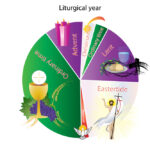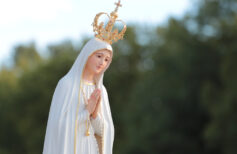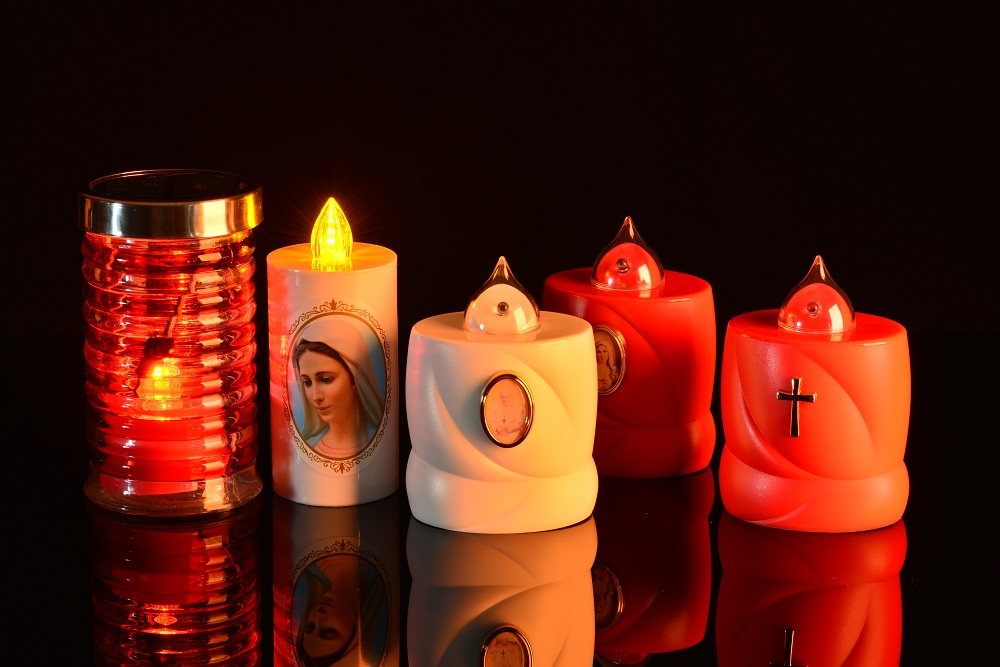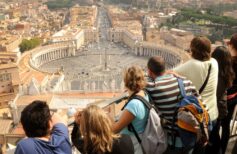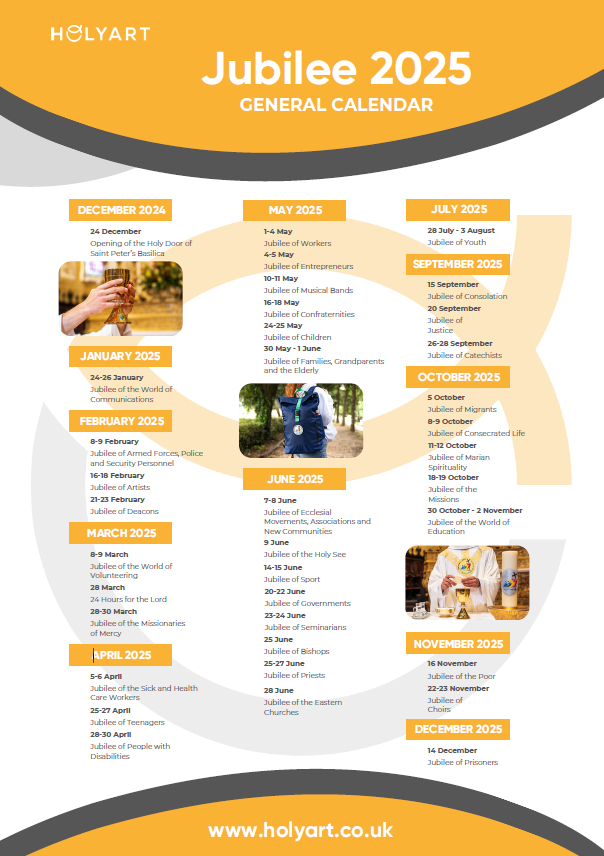50 days after Easter, she will untie the knots and celebrate Pentecost, which recalls the descent of the Holy Spirit among the disciples and the beginning of the Church’s mission. This year we celebrate it by reciting a Novena to Mary that unties the knots.
Contents
This year, Pentecost falls on 31 May. It is a movable feast, the date of which depends on when Easter was celebrated. Tradition has it that Pentecost falls exactly fifty days after Easter.
Pentecost is one of the most important celebrations for the Catholic Church. It derives from an ancient Jewish holiday, the Shavuot, which was celebrated seven weeks after Passover and imposed a pilgrimage to Jerusalem. It was precisely to celebrate the Shavuot that the disciples and apostles gathered in Jerusalem, and it was on that occasion that the Holy Spirit descended from heaven.

Pentecost: the day when we celebrate the Holy Spirit and the birth of the Church
Pentecost is perhaps, after Easter, one of the most important festivities…
Pentecost is also one of the religious anniversaries on which it is advisable to recite a Novena, a particular prayer that is usually addressed to Our Lady or to a saint to ask for her intercession to resolve a particularly difficult issue. To be effective, prayer must be recited for nine consecutive days. This year, in light of recent events, it seems right to us to propose a Novena dedicated to Mary who unties the knots, the one who offers her help to untangle the many knots of life, especially the most tangled ones.
The Origins and Meaning of Pentecost
We mentioned how Pentecost originally coincided with Shavuot, the Feast of Weeks. The term Pentecost comes from ancient Greek and means the fiftieth day. This feast fell 50 days after Passover, the Jewish Passover. It was one of the three feasts (the other two were Pesach and Sukkóth) on which it was necessary to go on a pilgrimage to Jerusalem bringing two loaves of bread as an offering to the Temple. The Shavuot was a feast linked to the land and the harvest. In fact, it is also called the “Harvest Festival” or “Feast of First Fruits”, and it was a moment of great joy.

5 places of pilgrimage to go to at least once in a lifetime
God’s action on this Earth leaves a strong mark that attracts us: here are five pilgrimages…
But the Shavuot also celebrates the joy of the gift of the Ten Commandments to Moses and the Jewish people’s choice to follow and obey them.
The apostles and disciples of Jesus also celebrated this feast.
In the Acts of the Apostles (Acts 2:1-11) we read that on the day of Pentecost, they all met together in the same place. According to the Acts, the Ascension into heaven of Jesus had taken place only a few days before, 40 days after the Resurrection, while according to the Gospel of Luke, it had taken place on the very day of the Resurrection. After Jesus’ Ascension into heaven, Our Lady and the Apostles found themselves praying together. At some point, the stillness of the day was shaken by a clap of deafening thunder, and tongues of fire came down from the sky to lick the heads of all those present, who suddenly began to speak in all the languages of the world, so that those who had come to hear the noise recognized each one their own. To that crowd, disturbed and amazed by that miracle, Peter said that it was Jesus, “Lord and Messiah”, risen from the kingdom of the dead and ascended to heaven, performed that miracle. Many converted instantly and asked to be baptised. Matthias, the apostle who had replaced Judas Iscariot among the Twelve, was also present and the Holy Spirit also descended on him, investing him with the ability to carry the Word of God everywhere.
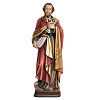
That crowd gathered around the Apostles who told of the life of Jesus, of his miracles, of his greatness, of his death and resurrection, was the first nucleus of the Catholic Church, sprung up by the work of the Holy Spirit descended in the form of fire to give eloquence to the disciples of Jesus.
The Holy Spirit: What It Is and What It Represents
The Holy Spirit is a person and is the third person of the Trinity. The divine substance, which is one, manifests itself in three different emanations, which nevertheless are all assimilable to the same substance. This process is called hypostasis, from the Greek hypostasis, “being subsistent”, or “substance”.
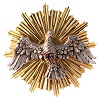
The Trinitarian Mystery is therefore composed of God the Father, God the Son and the Holy Spirit God, as the Nicene-Constantinopolitan Creed says: “I believe in the Holy Spirit, who is Lord and gives life, and proceeds from the Father (and the Son), and with the Father and the Son is adored and glorified and has spoken through the prophets.”
This formula of faith was formulated during the First Council of Nicaea (325) and then elaborated in the parts relating to the Holy Spirit at the First Council of Constantinople.

Holy Trinity: meaning and iconographic representation
The concept of Trinity summarises the fundamental doctrine of the Catholic Church…
In the Bible the Holy Spirit appears in several forms:
- Water, a symbol of new life (water sprung from the rock to save the Jewish people, Holy Spirit in baptism);
- Fire, a symbol of the power of the Spirit to transform things and infuse wisdom (for example at Pentecost),
- Wind, a symbol of the divine “breath” (always at Pentecost),
- Cloud and light (during the meeting with Moses on Mount Sinai, in the Annunciation to Our Lady, in the Transfiguration of Jesus, in the Ascension of Jesus to heaven);
- Seal, linked to the anointing symbol;
- Hand, by the laying on of hands, the Priest invokes the descent of the Holy Spirit and the blessing of God upon a believer;
- God’s Word is the power of God who made the Ten Commandments. With a warning gesture of the finger Jesus drove out the demons);
- The Dove, during the baptism of Jesus.
In the Old Testament, the Holy Spirit is mentioned in Genesis as a creative element in the context of Creation. The Spirit is also generative and thus is defined as the vital breath with which God infuses life into creation, renewing and changing it in time. Later the Holy Spirit will also be invested with a leading function because it will become the guide and the spur for kings, prophets and entire peoples who will move driven by it in the name of God.
In the New Testament, the Holy Spirit is fully revealed. It accompanies Jesus from His conception: “Then Mary said to the angel, «How is this possible? I am a virgin». The angel said to her, «The Holy Spirit will come upon you, and the power of the Highest will overshadow you. And so the child will be holy and will be called the Son of God». (Luke 1:34-35)
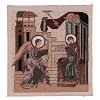
He will then appear during His Baptism, in the form of a dove that comes down from heaven and speaks with the voice of God: “As soon as He was baptised, Jesus came out of the water: and behold, the heavens opened and He saw the Spirit of God come down like a dove and come upon Him. Behold, a voice out of the heavens said, «This is my beloved Son, in whom I am well pleased»”. (Matthew 3:16-17)
The Holy Spirit will accompany many of Jesus’ miracles, especially those related to miraculous healings and the liberation of possessed men and women.
“But if I by the Spirit of God cast out demons, then the kingdom of God has come on you“. (Matthew 12:28)
“But Jesus, a wise man, went away from there. Many followed him, and he healed them all, and commanded them not to divulge him, that what was spoken by the prophet Isaiah might be fulfilled: «Behold my servant whom I have chosen, my beloved, in whom I am well pleased. I will put my spirit on him and he will proclaim justice to the nations.»” (Matthew 12:15-18)
The scribes who came down from Jerusalem said, «He has Beelzebul, and, by the prince of the demons he casts out the demons». He called them to him, and said to them in parables, «How can Satan cast out Satan? If a kingdom is divided in itself, that kingdom cannot stand; if a house is divided in itself, that house cannot stand. If Satan has risen against himself and is divided, he can’t stand but has an end. But no one can enter into the house of the strong man to plunder unless he first binds the strong man; and then he will plunder his house. Verily I say unto you, All sins shall be forgiven the children of men, and also all blasphemies which they shall utter: but he that blasphemes against the Holy Ghost shall have no forgiveness forever: he shall be guilty of everlasting guilt. Because they said, «He has an unclean spirit». (Mark 3:22-30)
At the moment of death, according to all the Gospels: “Jesus, uttering a great cry, gave up the spirit.” (Mark 15:37)
After the death and Ascension into heaven of Jesus, the Holy Spirit will return precisely at Pentecost, coming down from heaven in the form of tongues of fire that divided and settled on the disciples and Mary, giving them the faculty to preach the Gospel in languages previously unknown.
We must remember that Jesus himself had encouraged his disciples to pray after his death that the Holy Spirit would descend upon them:
“At that time Jesus said to his disciples: «26 When the Paraclete (the term by which the Holy Spirit is indicated in the Gospel according to John) comes, that I will send you to the Father, the Spirit of truth who proceeds from the Father, he will bear witness of me; 27 and you also bear witness because you have been with me from the beginning.
12 I have yet many things to say to you, but ye are not able to bear [them] now. 13 But when he comes, the Spirit of truth, he will guide you to all truth. He will not speak on his own, but he will speak what he hears and will declare to you the things that are coming. 14 He will glorify me because he will take from what is mine and declare it to you. 15 Everything that the Father has is mine; for this reason, I told you that he will take from what is mine and declare it to you.»” (Jn 15:26-27; 16:12-15)
According to Christian doctrine, the Holy Spirit brings seven gifts to those who receive him in themselves and are in a state of grace. Whoever possesses the virtue of Charity is already in possession of all 7 gifts. These gifts are not necessarily connected with Holiness but are necessary for salvation.
Here they are:
- knowledge;
- intellect;
- advice;
- strength;
- science;
- pity;
- fear of God.
Saint Paul instead listed nine fruits of the Holy Spirit, ready to sprout in those who were willing to receive it in themselves: “The fruit of the Spirit is instead: love, joy, peace, patience, benevolence, goodness, fidelity, meekness, self-control.” (Galatians 5:22)
Prayer to Mary who unties the knots while waiting for Pentecost
Pentecost is therefore the ideal occasion to recite the Novena to Mary that unties the knots.
After Jesus’ Ascension into heaven, Our Lady and the Apostles prayed together for nine days, until Pentecost, when finally the Holy Spirit descended on them. This probably gives rise to the custom of the Novena, particularly valuable for those who are in a situation of distress and suffering for themselves or for someone they love.

The Novena to Mary that loosens the knots
The Novena is a Christian devotional form that is usually practiced on a religious recurrence or a particularly important holiday…
The purpose for which this Novena is recited is to obtain help from Our Lady to dissolve a particular “knot” that generates distress and suffering. It is necessary to recite it for nine consecutive days, praying with humility and with absolute trust, and “always pray without tiring” (Lk 18:1), as Jesus said.
The devotion to Mary that unties the knots were to a large extent spread by Cardinal Bergoglio, today Pope Francis. The first Novena to Mary that unties the knots was written in 1998 by a priest from Buenos Aires Juan Ramón Celeiro. In 2008, this devotion was imprimatur from the Archbishopric of Paris, or the consent of the ecclesiastical authority required to validate works pertaining to religion.
Today, the Novena is recited all over the world and there are many versions of it. Here is one of them.
Virgin Mary, Mother of Beautiful Love,
The mother who has never abandoned a son who cries for help,
The mother whose hands work ceaselessly for her beloved children,
because they are driven by divine love and infinite mercy
that comes out of your heart, turn your gaze to me full of compassion.
Look at the pile of “knots” in my life.
You know my despair and my pain.
You know how paralysing these knots are to me, Maria,
Mother commissioned by God to untie the “knots” of your children’s lives,
I place the ribbon of my life in your hands.
In your hands, there is not a knot that is not loose.
Virgin mother, with your grace and your power of intercession before your Son Jesus,
my Savior, receive this “knot” today (name it if possible…).
For the glory of God, I ask you to dissolve it and untie it forever.
I hope for you. You are the only comforter God has given me.
You are the strength of my weak forces, the wealth of my miseries,
deliverance from all that prevents me from being with Christ.
Take my call.
Preserve me, guide me, protect me, be my refuge.
Amen
What Mary’s knots symbolise
The “knots” for which we invoke Mary can be all those problems that afflict us, sometimes even for years, and that we cannot solve. Misunderstandings and violence within the family, problematic children, sick, marriage crises, but also dangerous addictions, such as alcoholism and drug addiction, or a gambling vice.
And then incurable diseases, depression, unemployment, but also resentment, without guilt, negative feelings that poison the soul.
This gentle Madonna, depicted with a ribbon in her hands full of knots that her fingers untie, accepts the knots of those who turn to her with a sincere spirit and hope, with the promise of ending the pain.
